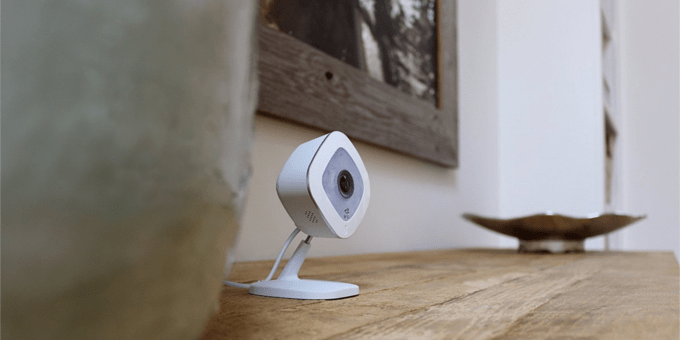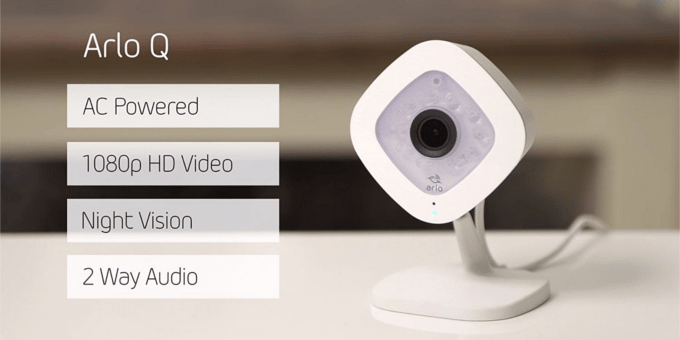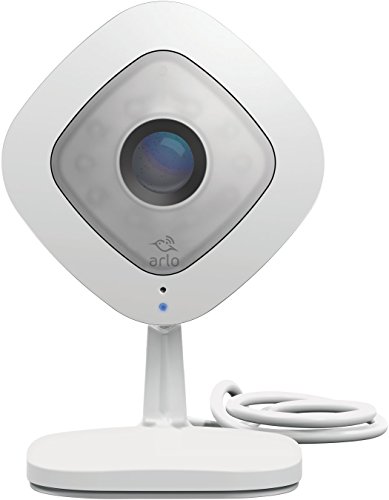While Amazon may be more recognizable as a brand, Arlo has built out a wider lineup of video monitoring solutions. When comparing the Arlo Q vs. Amazon Cloud Cam, we do feel that the Arlo model is the superior choice.
Amazon and Arlo both offer a great product, but the is missing a few of Arlo’s features. It’s a quality option for those looking for a camera that is more affordable, but there’s no denying that the Arlo Q is a better camera overall.
Read on for a full review of these two cameras, or use our navigation bar to jump directly to the sections that interest you most.
Arlo Q vs. Amazon Cloud Cam — Differences
Difference #1: Internet Connection – The first difference when comparing the Amazon Cloud Cam vs. Arlo Q is their internet connection technology. The Cloud Cam uses 2.4 GHz WiFi, which can potentially clog up your network due to its reliance on that single band.
The Arlo Q, on the other hand, is a dual-band device that works with both 2.4 and 5GHz frequencies. This means that the camera can spread its data transmission over both bands in order to reduce its impact on your connection.
Difference #2: CVR – Another benefit to the Arlo Q is its support for Continuous Video Recording. This is separate from their standard subscription plans, and is charged on a per-camera basis.
For 14 days of rolling video storage, you’ll pay $9.99 per month, while 30 days of storage is available for 19.99 per month.
The Amazon Cloud Cam does not offer CVR. However, it has the technology it would need to support it, meaning that we might see the feature added in the future.
Difference #3: Field of View – The Arlo Q’s 130° diagonal field of view is slightly better than the Amazon Cloud Cam’s 120°. It’s a relatively minor difference in the grand scheme of things, but there’s no denying that the Arlo Q does a slightly better job of keeping the entire room in view.
Difference #4: Cloud Storage & Subscriptions – Both cameras offer cloud storage and subscriptions, but there are some differences in the way the plans are structured.
Arlo Q offers a subscription called Arlo Smart, as well as an Arlo Smart Add-On that enables some additional security features.
By default, your home can support up to 5 cameras with 7 days of rolling cloud storage for free with the Arlo Smart Basic Plan. If you’d like the ability to add in more cameras and access storage, Arlo has you covered with their paid plans.
Arlo Smart Premier comes with a 1-month free trial but is normally priced at $9.99 per month. This plan gives you the ability to use up to 10 Arlo cameras and ups your cloud storage to 30 days.
Arlo Smart Premier offers support for 20 cameras and 60 days of cloud storage for $14.99 per month.
The Arlo Smart Add-On is a more unique package focused on adding new features rather than additional storage and camera support. If you’d like to use this add-on without a subscription, you’ll pay $2.99 per camera. However, opting for Smart Premier or Elite gives you access to the add-on package free of charge.
Arlo Smart Add-On expands your cameras’ motion detection capabilities with access to Person Detection. Additionally, Rich Notifications make it easy to respond to alerts with a single swipe, and e911 Emergency Call Service will send the authorities to your home in the event of an emergency rather than tracking your cell phone.
With the Amazon Cloud Cam, you’ll have access to the last 24 hours of clips for free and support for a single camera.
For more storage, support for more cameras, motion activity zones, and person detection, you’ll have to pay for a subscription.
Amazon offers three different plans: Basic, Extended, and Pro. All three plans will enable motion zones and person detection. The only difference between the tiers is the amount of video storage and the maximum amount of cameras.
Basic, at a price of $6.99 per month or $69.99 per year, allows for 7 days of video clips and up to 3 cameras.
Extended costs $9.99 per month or $99.99 per year, and supports 5 cameras and 14 days of clips.
Pro allows for 30 days of storage and 10 cameras and costs $19.99 per month or $199.99 per year.
It’s easy to see that Arlo’s subscription model offers more for less. You get access for more as a baseline than you do when you pay for Amazon’s basic plan, and the Amazon Pro tier is more expensive than Arlo’s with significantly fewer features.
Add in the fact that you have extra options available with the Arlo Smart Add-on, and it’s pretty clear which brand comes out on top.
Difference #5: Voice Control – Voice control is available on with both cameras, and they both have their pros and cons.
The Arlo Q supports both Amazon Alexa and Google Assistant. The Alexa support is particularly useful, as it allows you to use devices like the Echo Show or Echo Spot to monitor your video. With the Show, however, you won’t have access to the two-way audio features.
The Amazon Cloud, as expected, does not work with Google Assistant. However, their Amazon Alexa integration is far more impressive. In addition to the two-way audio support on the Echo Show that the Arlo Q lacks, you’ll be able to access your feed through pretty much any Amazon device.
So, if you’re a fan of Google Assistant you’ll need to go with the Arlo Q. To get the most out of Amazon Alexa, however, the Amazon Cloud Cam is the way to go.
Difference #6: IFTTT & Stringify – The last major difference between the two models is that Arlo Q supports IFTTT and Stringify, while Amazon Cloud Cam does not.
These two trigger systems allow you to tie your smart devices together, doing cool things like causing your lights to flash when your cameras detect activity.
The lack of support for these systems means you’re going to see less integration by default with Cloud Cam.
Arlo Q vs. Amazon Cloud Cam — Comparison Chart
| Arlo Q | ||
|---|---|---|
| Video resolution | 1080p HD | Up to 1080p |
| Frames per Second | 30 FPS | 30 FPS |
| Video Format | H.264 | H.264 |
| On-Demand Live View | Yes | Yes |
| Record Live View | Yes | Yes |
| Field of View | 130° | 120° |
| Zoom | 8x digital zoom | Yes |
| Power | AC | AC |
| Optional Power Source | No | No |
| Two-Way Audio | Yes | Yes |
| Motion Detection | Up to 50 feet | Yes |
| Motion Zones | Up to 3 activity zones | with a Cloud Cam subscription |
| Person Detection | With Subscription | with Subscription |
| Facial Recognition | No | No |
| Sound Detection | Yes | Yes |
| Night Vision | 850 nm LEDs: illuminates up to 25 feet IR cut-off filter |
850 nm LEDs: illuminates up to 25 feet IR cut-off filter |
| Internet Connection | WiFi: 2.4 & 5GHz | WiFi: 2.4 Ghz |
| Requires a Base Station | No | No |
| Siren | No | No |
| 24/7 Recording | Optional | No |
| Local Backup Storage | No | No |
| Cloud Storage | 7-Day Free / Subscription | 24 hours Free / Subscription |
| Review, Share, & Save | Yes | Yes |
| e911 Emergency Call | With Subscription | No |
| Instant App Alerts | Yes | Yes |
| App Support | Android, iOS, FireOS, Web | Android, iOS, FireOS, Web |
| Rich Notifications | With Subscription | No |
| Weather-resistant | No | No |
| Amazon Alexa | Echo Show, Echo Spot | Echo Show, Echo Spot |
| Google Assistant | Yes | No |
| IFTTT | Yes | No |
| Stringify | Yes | No |
| Operating Temperature | Indoors | 32°F to 95°F |
| Dimension | 2.75 x 2.80 x 4.50 in | 4.1 x 2.36 in |
| Color | White | White |
Arlo Q vs. Amazon Cloud Cam — Things in Common

Video Quality – Video quality is perhaps the most important consideration when buying a camera — especially for models that are intended for security applications. Both the Amazon Cloud Cam and Arlo Q offer 1080p HD quality recorded at 30 FPS. As an added bonus, H.264 video compression ensures your cameras won’t clog up your network’s bandwidth.
Live View – Access and record your feed whenever you please with On-Demand Live View — Available at no additional cost.
Zoom – Sometimes the action is front and center, but other times you’ll need to zoom in to get the finer details. Fortunately, both cameras include a digital zoom feature to make it easier to get that perfect recording.
Power Options – Like most cameras, the Arlo Q and Amazon Cloud Cam are powered through an AC plug. If you’re looking for a more convenient option, take a look at the Arlo Q Plus with its power over Ethernet feature.
Two-Way Audio – Both cameras allow you to both listen in and talk back with two-way audio. It’s great for scaring off package thieves, or even just to keep your cats off of the counter!
Motion & Sound Detection – Motion and Sound Detection are one of the features that separate these “smart” cameras from more traditional video cameras. You’ll receive alerts and video will be recorded when activity is detected, and motion zones and person detection allow for more accurate notifications.
Night Vision – Keep your home protected around the clock with Night Vision featured on both the Amazon Cloud Cam and Arlo Q. Both cameras use 850nm LEDs that can illuminate up to 25 feet, as well as an IR cut-off filter for a crisper and clearer picture.
App Support – Accessing your camera and controlling settings is a breeze regardless of your choice in a device, with app support for Android, iOS, FireOS, and Web.
Arlo Q vs. Amazon Cloud Cam — Accessories

There are a few accessories you might want to consider purchasing alongside your new camera — most of which are focused on mounting and installation.
For the Arlo Q, the makes installation a breeze, while Colorful Silicone Skins are great for making your camera look a little less drab.
The Amazon Cloud Cam has multiple different options for installation, such as the Outlet Mount, Wall Mount, and Hole-Free Mount.
Arlo Q vs. Amazon Cloud Cam — Our Thoughts

It’s easy to see when comparing the Arlo Q vs. Amazon Cloud Cam that Arlo Q offers more features, so it’s our top pick if you’re looking for quality above all else. With options like CVR, a superior field of view, and free cloud storage for up to 7 days instead of just 24 hours. And if you’re looking for local storage and better Internet and Power options, make sure to check out the Arlo Q Plus.
The is a viable option and there’s not necessarily anything wrong with it — plus it’s available at a better price. However, the subscription plans are not nearly as attractive as what you’d have access to with Arlo, which makes it a little less attractive overall.
Last update on 2024-04-19 at 04:42 / Affiliate links / Images from Amazon Product Advertising API



Arlo Q frame rate is actually only 15 fps.